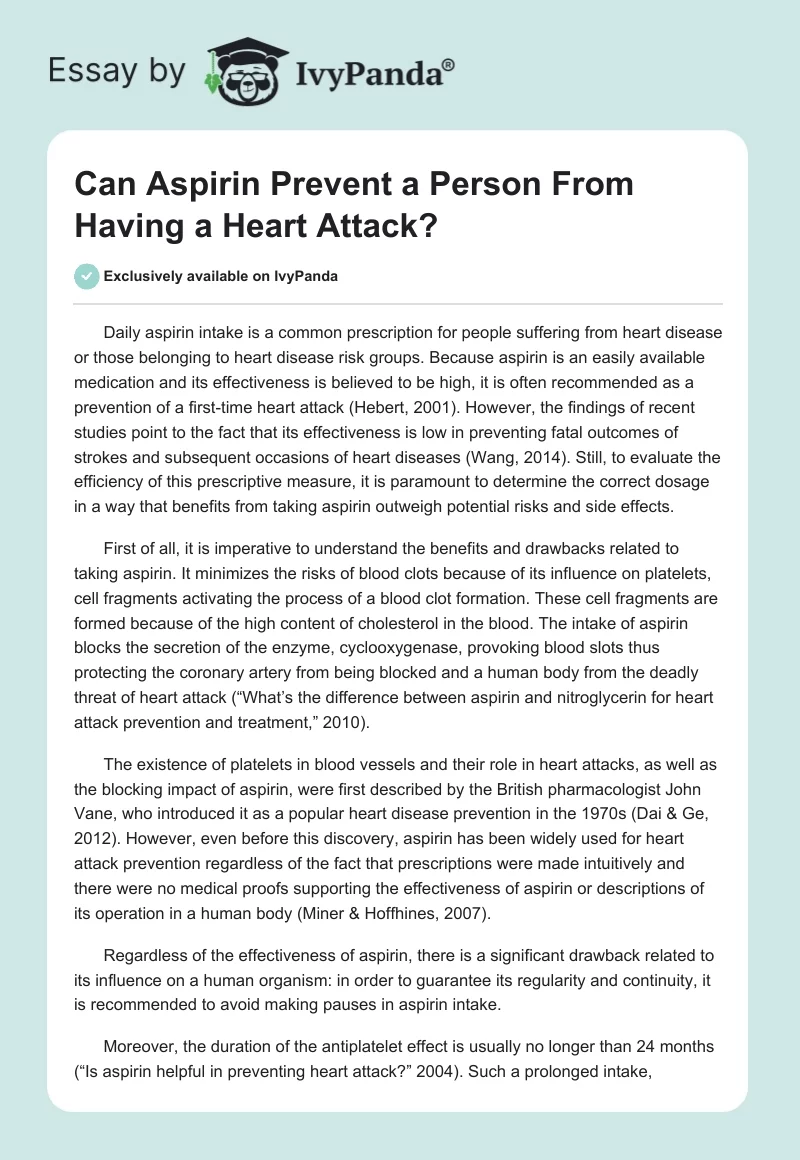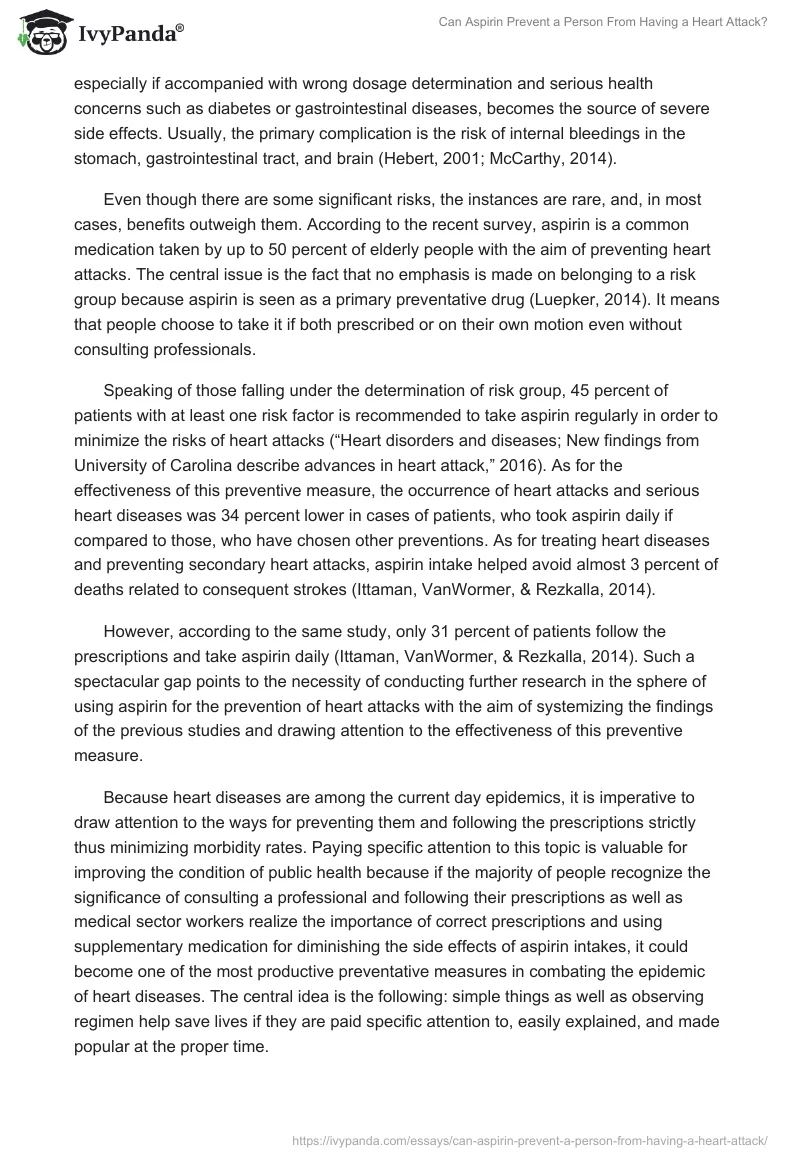Daily aspirin intake is a common prescription for people suffering from heart disease or those belonging to heart disease risk groups. Because aspirin is an easily available medication and its effectiveness is believed to be high, it is often recommended as a prevention of a first-time heart attack (Hebert, 2001). However, the findings of recent studies point to the fact that its effectiveness is low in preventing fatal outcomes of strokes and subsequent occasions of heart diseases (Wang, 2014). Still, to evaluate the efficiency of this prescriptive measure, it is paramount to determine the correct dosage in a way that benefits from taking aspirin outweigh potential risks and side effects.
First of all, it is imperative to understand the benefits and drawbacks related to taking aspirin. It minimizes the risks of blood clots because of its influence on platelets, cell fragments activating the process of a blood clot formation. These cell fragments are formed because of the high content of cholesterol in the blood. The intake of aspirin blocks the secretion of the enzyme, cyclooxygenase, provoking blood slots thus protecting the coronary artery from being blocked and a human body from the deadly threat of heart attack (“What’s the difference between aspirin and nitroglycerin for heart attack prevention and treatment,” 2010).
The existence of platelets in blood vessels and their role in heart attacks, as well as the blocking impact of aspirin, were first described by the British pharmacologist John Vane, who introduced it as a popular heart disease prevention in the 1970s (Dai & Ge, 2012). However, even before this discovery, aspirin has been widely used for heart attack prevention regardless of the fact that prescriptions were made intuitively and there were no medical proofs supporting the effectiveness of aspirin or descriptions of its operation in a human body (Miner & Hoffhines, 2007).
Regardless of the effectiveness of aspirin, there is a significant drawback related to its influence on a human organism: in order to guarantee its regularity and continuity, it is recommended to avoid making pauses in aspirin intake.
Moreover, the duration of the antiplatelet effect is usually no longer than 24 months (“Is aspirin helpful in preventing heart attack?” 2004). Such a prolonged intake, especially if accompanied with wrong dosage determination and serious health concerns such as diabetes or gastrointestinal diseases, becomes the source of severe side effects. Usually, the primary complication is the risk of internal bleedings in the stomach, gastrointestinal tract, and brain (Hebert, 2001; McCarthy, 2014).
Even though there are some significant risks, the instances are rare, and, in most cases, benefits outweigh them. According to the recent survey, aspirin is a common medication taken by up to 50 percent of elderly people with the aim of preventing heart attacks. The central issue is the fact that no emphasis is made on belonging to a risk group because aspirin is seen as a primary preventative drug (Luepker, 2014). It means that people choose to take it if both prescribed or on their own motion even without consulting professionals.
Speaking of those falling under the determination of risk group, 45 percent of patients with at least one risk factor is recommended to take aspirin regularly in order to minimize the risks of heart attacks (“Heart disorders and diseases; New findings from University of Carolina describe advances in heart attack,” 2016). As for the effectiveness of this preventive measure, the occurrence of heart attacks and serious heart diseases was 34 percent lower in cases of patients, who took aspirin daily if compared to those, who have chosen other preventions. As for treating heart diseases and preventing secondary heart attacks, aspirin intake helped avoid almost 3 percent of deaths related to consequent strokes (Ittaman, VanWormer, & Rezkalla, 2014).
However, according to the same study, only 31 percent of patients follow the prescriptions and take aspirin daily (Ittaman, VanWormer, & Rezkalla, 2014). Such a spectacular gap points to the necessity of conducting further research in the sphere of using aspirin for the prevention of heart attacks with the aim of systemizing the findings of the previous studies and drawing attention to the effectiveness of this preventive measure.
Because heart diseases are among the current day epidemics, it is imperative to draw attention to the ways for preventing them and following the prescriptions strictly thus minimizing morbidity rates. Paying specific attention to this topic is valuable for improving the condition of public health because if the majority of people recognize the significance of consulting a professional and following their prescriptions as well as medical sector workers realize the importance of correct prescriptions and using supplementary medication for diminishing the side effects of aspirin intakes, it could become one of the most productive preventative measures in combating the epidemic of heart diseases. The central idea is the following: simple things as well as observing regimen help save lives if they are paid specific attention to, easily explained, and made popular at the proper time.
References
Dai, Y., & Ge, J. (2012). Clinical use of aspirin in treatment and prevention of cardiovascular disease. Thrombosis, 2012, 1-7. doi: 10.1155/2012/245037
Heart disorders and diseases; New findings from the University of Carolina describe advances in a heart attack. (2016, Feb. 20). Obesity, Fitness, and Wellness Week, p. 3026.
Hebert, P. (2001, Jan. 7). Myocardial infarction; Study confirms aspirin helpful in preventing first heart attack. Heart Disease Weekly, p. 10.
Is aspirin helpful in preventing heart attack? (2004). Association of Operating Room Nurses, AORN Journal, 79(5), 1024.
Ittaman, S. V., VanWormer, J. J., & Rezkalla, S. H. (2014). The role of aspirin in the prevention of cardiovascular disease. Clinical Medicine and Research, 12(3-4), 147-154.
Luepker, R., Steffen, S. S., Duval, S., Zantek, N. D., Zhou, X., & Hirsch, A. T. (2014). Preventive cardiology: Population trends in aspirin use for cardiovascular disease prevention 1980-2009: The Minnesota Survey. Journal of the American Heart Association, 3, 1-7. doi:10.1161/JAHA.115.002320
McCarthy, M. (2014). FDA questions the use of aspirin for primary prevention of stroke and heart attack. BML: British Medical Journal, 348(2), 3168.
Miner, J., & Hoffhines, A. (2007). The discovery of aspirin’s antithrombotic effects. Texas Heart Institute Journal, 34(2), 179-186.
Wang, T. Y. P. (2014). Aspirin for first-line heart attack prevention: There is still no consensus; the benefits must be weighed against the risks. Duke Medicine Health News, 20(11), 5-6.
What’s the difference between aspirin and nitroglycerin for heart attack prevention and treatment? (2010). Duke Medicine Health News, 16(8), 8.


